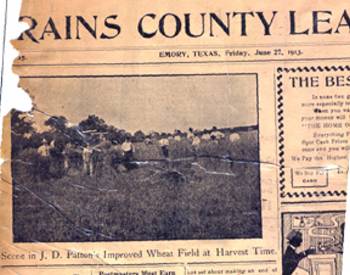 |
 |
J.D. Patton from the north part of the county was in town attending court the first part of the week and made this office a call. He brought us a bunch of wheat, which measured 41 inches. This is a new kind of wheat, called the bunch wheat, and as far as his experiment has gone he is highly pleased with it. Mr. Patton got the seed for this wheat at Commerce, paying $5.00 per bushel for it, and it is claimed that it never raises less than 35 bushels to the acre, which is about double the usual production. Mr. Patton is one of our most progressive farmers and is always hunting for better seed and better methods. We need more such farmers in this country.
Best Crop in History
On last Monday afternoon a party of Lone Oak citizens drove out from town to the J.D. Patton farm in the Cody settlement. Those in the party were: John Mann, T.E. Vanlandingham, E.M. Alkire, R.W. Beasley, Tom Harrison, John N. White, R.A. Weeden, Geo. Fortenberry, W.E. Dickey, T.P. Stillwell, Joe M. Moore, The News editor.
The men went down in autos and viewed Mr. Pattons fine wheat. Mr. Patton has ten acres of the finest wheat ever harvested in this section, we do not speak from hearsay, this is sanctioned by everyone who visited the field Monday. The visitors took sufficient time to walk through the wheat, threshed some in their hands and examined same thoroughly and everyone who knows anything about the small grain crops in this section of the State say the grains are the largest, most perfect, smoothest and will weigh out more to the bushel than any wheat ever grown here in the past. It was generally conceded that the yield would be between twenty-five and thirty bushels to the acre, with the average at thirty bushels. The seed that this successful farmer sowed is a new variety recently introduced in this section. He secured the seed at Wolf City just as an experiment, and the same has proven to be a howling success. Mr. Patton stated Monday that he would make affidavit to the fact that he sowed only one-half bushel of seed to the acre, making five bushels for the ten acres. See what this means, even if he were to make fifteen or twenty bushels to the acre; but as it is, he will average at least thirty bushels to the acre 300 bushels of grain harvested from a planting of five bushels of see means much more doesnt it? Well, that is what Mr. Patton will do. He intends to save every grain of the wheat for seeding purposes, and has already had such a demand for this excellent seed wheat he is not sure that he will be able to supply all who call on him, so youd better hurry if you intend to sow wheat this fall and want the best. But Mr. Patton is not only a wheat raiser; he is giving much space on his farm for the growing of other grains, fruits, etc. If you dont believe this just ask some of the men who had the nerve to tackle the peach trees it might not be best for us to name them anyway the ones who missed the peach orchard, missed a treat well say that much. And then his grape crop will be a bumper too. Some of the visitors spoke as though they would go back before many weeks and look over some of the other grain Mr. Patton is growing they said about the time that grapes are ripe would be the proper time for them to make another visit to this hospitable home.--Lone Oak News
Lone Oak, Texas, June 23, 1913
Friend Hill:
I measured my wheat land Saturday with a tapeline and there were 8-3/4 acres. From this land I threshed 212-1/2 bushels of wheat, an average of 25 bushels to the acre. There was about 3-1/2 acres of low, flat land which was too rich and the wheat grew too tall and blew down; therefore, the binder could not save more than one-half of it. If all had been on up land (not so rich) I believe, like lots of others who saw the wheat, that I would have gotten 30 bushels to the acre. This is a boarded wheat. Only requires ½ bushel to seed an acre, and being very deep rooted, it stands the drought and cold weather fine. This wheat is a great buncher. Nothing uncommon to count as many as 100 straws or grains from one grain; therefore requires less to seed an acres and will double the yield of many varieties. E.M. Alkirel (grain dealer) of Lone Oak tested my wheat Saturday, which tested 60 pounds up weight to the bushel.Yours Respectfully,
J.D. Patton
(Rains County Leader, June 27, 1913)